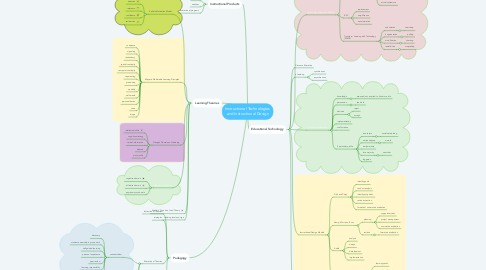
1. Learning Theories
1.1. Keller's Motivation Model
1.1.1. attention
1.1.2. relevance
1.1.3. confidence
1.1.4. satisfaction
1.2. Mayer'a Multimedia Learning Principles
1.2.1. coherence
1.2.2. signaling
1.2.3. redundancy
1.2.4. spatial contiquity
1.2.5. temporal contiquity
1.2.6. segmenting
1.2.7. pretraining
1.2.8. modality
1.2.9. multimedia
1.2.10. personalization
1.2.11. voice
1.2.12. image
1.3. Gange's Domains of Learning
1.3.1. intellectual skills
1.3.2. cognitive strategy
1.3.3. verbal information
1.3.4. attitude
1.3.5. motor skills
1.4. Blossom Taxonomy
1.4.1. cognitive domain
1.4.2. affective domain
1.4.3. psychomotor domain
1.5. Sweller's Cognitive Load Theory
1.6. learning level and type
2. Padagogy
2.1. Instructional Theories
2.2. strategies
2.3. Educational Theories
2.3.1. constructivism
2.3.1.1. discovery
2.3.1.2. student ownership in group work
2.3.1.3. self guided learning
2.3.1.4. personal experience
2.3.1.5. peer review
2.3.1.6. learning responsibilty
2.3.1.7. knowledge development
2.3.2. cognitivism
2.3.3. behaviourism
2.4. cognitive tools
3. Instructional Products
3.1. e books
3.2. websites
3.3. educational programs
4. Educational Technology
4.1. Technology Integration Models
4.1.1. Technology Acceptance Model
4.1.1.1. external variables
4.1.1.2. perceived usefulness
4.1.1.3. attitude towards using
4.1.1.4. behavioral intention use
4.1.1.5. actual system use
4.1.2. RAT
4.1.2.1. replacement
4.1.2.2. amplification
4.1.2.3. transformation
4.1.3. Transform Learning with Technology (SAMR)
4.1.3.1. substitution
4.1.3.1.1. searching
4.1.3.2. augmentation
4.1.3.2.1. polling
4.1.3.3. modification
4.1.3.3.1. charting
4.1.3.4. redefinition
4.1.3.4.1. storytelling
4.2. Distance Education
4.3. e-learning
4.3.1. synchronous
4.3.2. asynchronous
4.4. Diffusion of Innovation
4.4.1. knowledge
4.4.1.1. exposed, not inspired to find more info
4.4.2. persuasion
4.4.2.1. seek info
4.4.3. decision
4.4.3.1. reject
4.4.3.2. accept
4.4.4. implementation
4.4.5. confirmation
4.4.6. 5 particular profile
4.4.6.1. innovators
4.4.6.1.1. social networking
4.4.6.2. early adopters
4.4.6.2.1. e-mails
4.4.6.3. early majority
4.4.6.4. late majority
4.4.6.4.1. searcher
4.4.6.5. laggards
4.5. Instructional Design Models
4.5.1. Dick and Carey
4.5.1.1. identify goals
4.5.1.2. conduct analysis
4.5.1.3. identify entry behv.
4.5.1.4. revise instruction
4.5.1.5. formative/ summative evaluation
4.5.2. Kemp, Morrison, Ross
4.5.2.1. planning
4.5.2.1.1. support services
4.5.2.1.2. project management
4.5.2.1.3. summative evaluation
4.5.2.2. revision
4.5.2.2.1. formative evaluation
4.5.3. Addie
4.5.3.1. analysis
4.5.3.2. design
4.5.3.3. development
4.5.3.4. implementation
4.5.4. Four Component for Design Models
4.5.4.1. learning tasks
4.5.4.2. supportive information
4.5.4.3. procedural information
4.5.4.4. part-task practice

